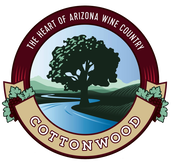About Cottonwood, Arizona
As with other communities in the Verde Valley, the City shares a rich and lengthy history. The region has long been home to Native Americans, particularly the Sinaugua and later the Yavapai and Apache. The first Anglo settlers in the area farmed and provided goods for the soldiers at Camp Verde and for the miners in Jerome beginning in the late 1870s. William Clark and Jimmy Douglas developed major smelters and the mining communities of Clarkdale (1912) and Clemenceau (1917), respectively. Clemenceau, located near the intersection of Willard Street and Mingus Avenue was a complete company town with thousands of residents, a school and other community facilities. Today, few people recognize the size and complexity of the original "Smelter City."
During this period, mining companies that closely regulated commerce, industry, employment and even housing opportunities administered Jerome, Clarkdale and Clemenceau.
Old Town Cottonwood became a haven for those seeking to be free from the prejudice and regulation of nearby company towns. Main Street was created 1908 when Charles Stemmer and Alonzo Mason used a mule team to pull and drag through brush. The Mason Addition, Willard Addition, Hopkins Ranch No. 2 and other tracts were platted during the next decade coinciding with the development of Clemenceau on higher ground about one mile to the south.
The Clemenceau smelter closed on December 31, 1936 with a great loss of jobs and disruption to the area's economy. The Cottonwood Women's Club organized to feed those in need and raised money to build the Cottonwood Civic Center (1939) with labor provided through the Works Progress Administration. The copper industry continued its decline culminating with the closure of the Phelps Dodge operation in the 1950s. Population plummeted in the region as the mining industry declined. Jerome's population declined from about 8,000 to nearly 0, while Clarkdale went from nearly 4,000 to several hundred.
During this period, mining companies that closely regulated commerce, industry, employment and even housing opportunities administered Jerome, Clarkdale and Clemenceau.
Old Town Cottonwood became a haven for those seeking to be free from the prejudice and regulation of nearby company towns. Main Street was created 1908 when Charles Stemmer and Alonzo Mason used a mule team to pull and drag through brush. The Mason Addition, Willard Addition, Hopkins Ranch No. 2 and other tracts were platted during the next decade coinciding with the development of Clemenceau on higher ground about one mile to the south.
The Clemenceau smelter closed on December 31, 1936 with a great loss of jobs and disruption to the area's economy. The Cottonwood Women's Club organized to feed those in need and raised money to build the Cottonwood Civic Center (1939) with labor provided through the Works Progress Administration. The copper industry continued its decline culminating with the closure of the Phelps Dodge operation in the 1950s. Population plummeted in the region as the mining industry declined. Jerome's population declined from about 8,000 to nearly 0, while Clarkdale went from nearly 4,000 to several hundred.
The Verde Valley Region
The Verde Valley includes about 714 square miles located in the geographic center of Arizona, about 100 miles north of the Phoenix metropolitan area. The Verde River runs through the valley from northwest to southeast and is augmented by flows from Sycamore Canyon, Oak Creek, Beaver Creek and West Clear Creek. The area is unsurpassed in its variety of physical beauty with the red rocks and Mogollon Rim to the north and east and the Black Hills and Mingus Mountain dominating the western and southern portions of the valley.
The City of Cottonwood is located adjacent to the Verde River at elevations ranging from 3,300 feet to 3,900 feet above sea level and experiences a mild climate which, together with its proximity to an abundance of natural amenities such as the Grand Canyon, Sedona, Dead Horse Ranch State Park, Tuzigoot National Monument and the historic mining communities of Clarkdale and Jerome, continues to attract steady growth and tourism.
The City of Cottonwood is located adjacent to the Verde River at elevations ranging from 3,300 feet to 3,900 feet above sea level and experiences a mild climate which, together with its proximity to an abundance of natural amenities such as the Grand Canyon, Sedona, Dead Horse Ranch State Park, Tuzigoot National Monument and the historic mining communities of Clarkdale and Jerome, continues to attract steady growth and tourism.
Tourism & Economic Development, City of Cottonwood
The City of Cottonwood serves as the Destination Marketing Organization for the destination. We work together with community partners, businesses, and neighbors to make it as robust as possible. Please contact us if you have questions, need more information, or ideas to share.






